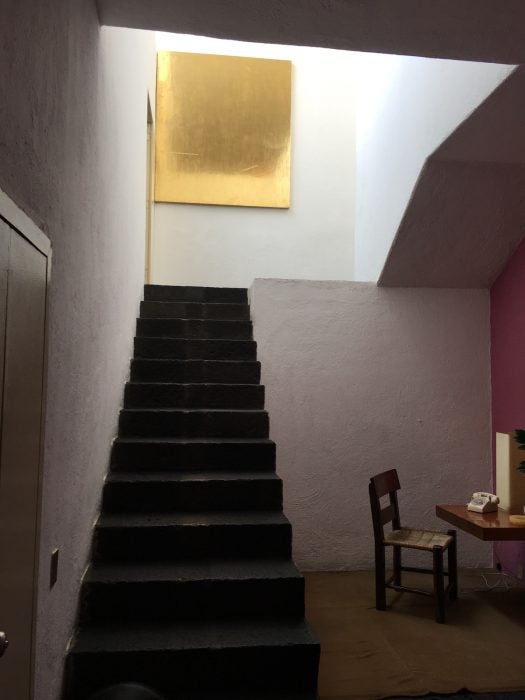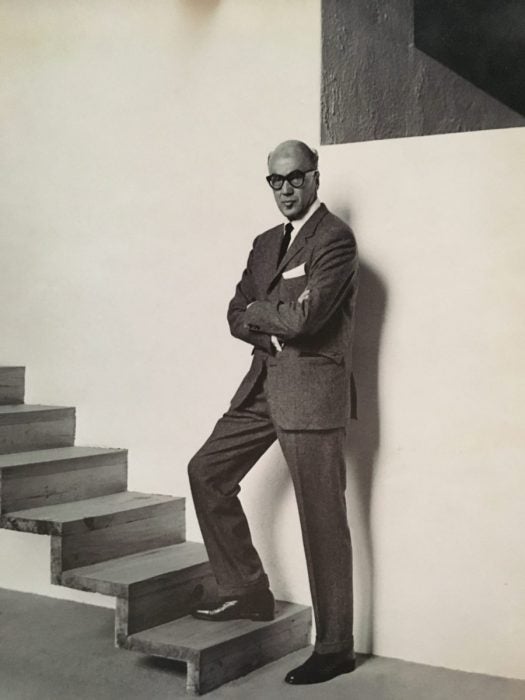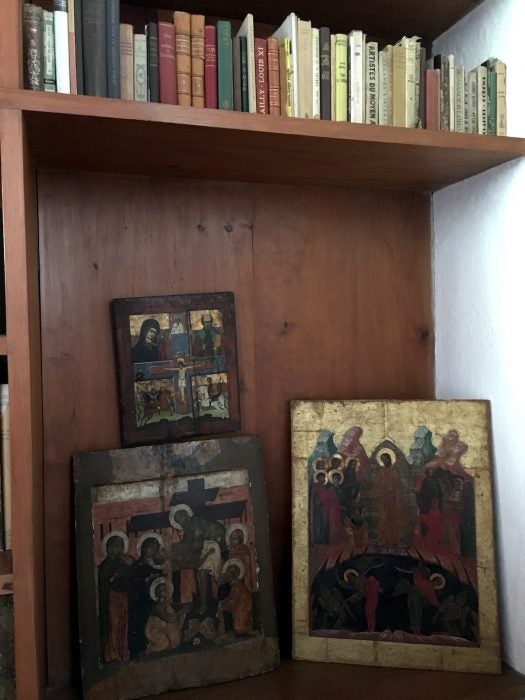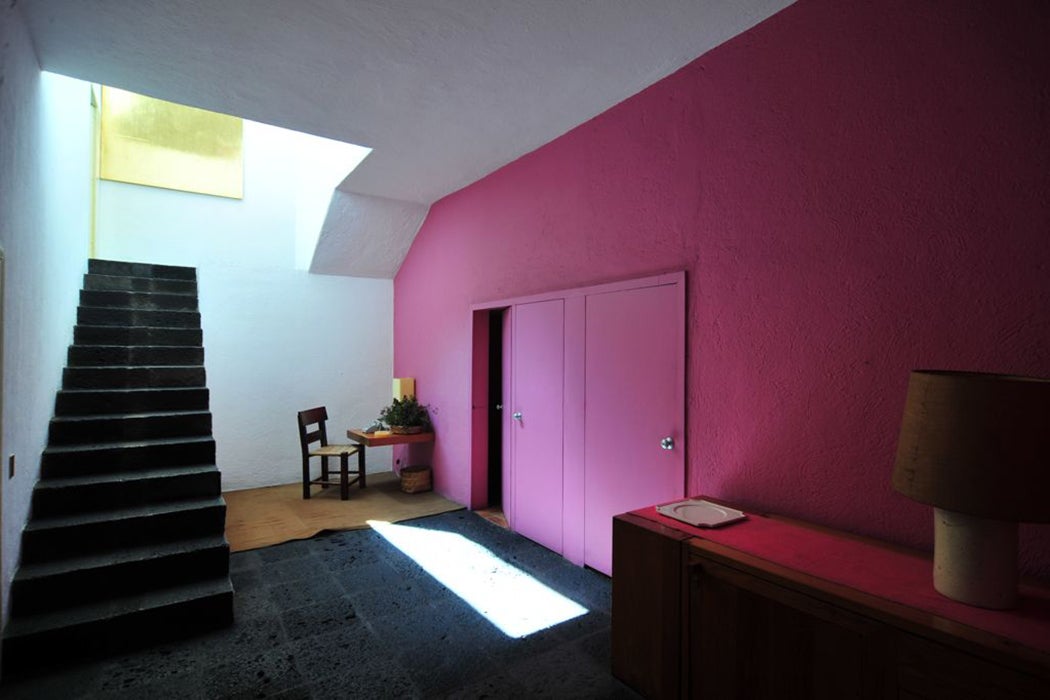From the outside, Casa Luis Barragán appears to be a nondescript two-story building, all straight lines with a handful of small windows. A sign in a first-floor window reads “By appointment only,” and the only hint that something interesting might be inside is a silver mirrored orb visible in the second-floor window. The Casa was the home and studio of one of the most famous Mexican architects of the twentieth century, Luis Barragán (1902–1988). The building, in what is now the Miguel Hidalgo district of Mexico City, has long been a mecca for architects and design aficionados from around the world.

In the United States, Barragán is not as well-known as his American or European contemporaries, such as Frank Lloyd Wright, Mies van der Rohe, or Le Corbusier. But during his lifetime, he was the subject of a solo exhibition at the Museum of Modern Art in 1976 (with a gorgeous catalog by Emilio Ambasz), and he was awarded the Pritzker Prize, an annual award for achievement in architecture, in 1980. With the current popularity of midcentury modernism in the U.S. and elsewhere, recent exhibitions and gallery shows on Latin American architecture of the same time period have renewed interest in Barragán’s work. Casa Barragán has become a popular fixture for those visiting Mexico City, thanks to its bright colors, wild garden, and sky-framing rooftop. But to see any of these things, you have to sign up for a tour.
As I wait outside the building for the tour to begin, visitors arrive alone or in pairs. There are 12 of us in all, a purposely limited group that allows the guide to enclose us in small spaces within the house as she narrates the importance of certain shadows and ceiling heights.
Casa Barragán was built in 1948, and served as the architect’s primary residence and studio until his death in 1988. In 1994 the Government of Jalisco turned it into a museum, and in 2004 it was named a UNESCO World Heritage site. According to the Casa Barragán web site, it is “the only individual property in Latin America to have achieved such a distinct honor, being—as stated by the UNESCO itself—a masterpiece in the development of the modern movement that merges traditional and vernacular elements, as well as diverse philosophical and artistic currents throughout time, into a new synthesis.” “Synthesis” is often a buzzword for midcentury modernism, particularly in Latin America, where artists and architects combined local materials and techniques with the tenets of the International Style espoused by the Museum of Modern Art in New York: geometric forms, the use of concrete and steel, large glass windows, mass-produced furniture, and the elimination of ornament.
In a short piece called “The Uses of Tradition,” Octavio Paz wrote that Barragán’s model “is neither the palace nor the skyscraper. His architecture is rooted in the Mexican village with its streets, limited by towering walls, that in turn lead to plazas and fountains… The art of Barragán is an example of how to employ our popular tradition with intelligence.” At this time, Mexican artists and architects, most famously Frida Kahlo and Diego Rivera, were concerned with mexicanidad, a sort of national pride that drew on the indigenous traditions of the area, and how they could create a uniquely Mexican art. Their work synthesized the modern movements in art and architecture in Europe with local imagery and forms, going back to the early Mesoamerican civilizations. Barragán’s architecture and furniture designs drew upon traditional Mexican forms as well as the Mediterranean influence of the Spanish conquerors. As Paz points out, these design choices weren’t merely aesthetic, they were also political: “Our nascent democracy can and should be nourished by forms of coexistence and solidarity that are still alive in Mexico. These forms are a political and moral legacy that we should revise and adapt to the conditions of modern life. To be truly modern we must first come to terms with our tradition.” Barragán was well positioned to do both.
Luis Barragán Morfin was born in 1902 into a wealthy family in Guadalajara, where he studied engineering. He began his career in the conservative city of his birth, where much of the architecture was still primarily utilitarian, or in the colonial Andalusian and French fin-de-siècle styles. Barragán made several trips to Europe and the United States, where he encountered the work of Le Corbusier and Richard Neutra, his fellow countryman José Clemente Orozco (then living in New York, where Jackson Pollock would become his apprentice), and Ferdinand Bac, an obscure landscape architect who played a central role in Barragán’s thinking about landscape design. Other influences included Europeans who emigrated to Mexico in the postwar years, including architect Max Cetto and sculptor Matthias Goeritz, who, with Barragán, designed the famous Torres de Satélite sculpture in Mexico City.

Mexican artists and architects profoundly influenced Barragán’s use of color and material, among them Jesús Reyes Ferreira, Rufino Tamayo, and Juan O’Gorman. The architecture scholar Federica Zanco describes this transition in Barragán’s work from the beginning of his career in Guadalajara to his early years in Mexico City, including his increasing use of color, geometric forms, and almost abstracted use of space. In Guadalajara, Barragán grew tired of creating similar buildings for his wealthy, provincial clients. In 1936, he moved to Mexico City, where buildings in the functionalist style of Le Corbusier were already being built. In the 1940s, he began to buy cheap land outside the city in which to build his own projects. Among these projects was Casa Barragán, which in 1948 was located near the town of Tacubaya, a working-class area.
The tour begins in a tiny entryway that requires us to become comfortable with each other immediately. The room is dim, with a small rectangle of natural light coming in through a filtered window above the door to the street. We feel immediately removed from the outside world, yet stuck in a sort of intermediary state. One of the walls is made of light wood, local to the area, and as the guide flips the light switch, we suddenly see that the other walls are a bright yellow. The light itself is recessed behind the wood in the top corner of the room, so the low-ceilinged hallway is brightened by a soft light. A few volcanic stone stairs lead up to the next door, giving the sense that we are ascending from darker, cramped quarters into something more comfortable. And indeed, once the door opens, we do: a far-larger room with a two-story ceiling, a central staircase, a bright pink wall, and a large gold-leaf painting on the landing of the staircase. Our bodies instinctively breathe deeper, and we disperse throughout the larger room to admire the small desk and phone, the cabinets, the black stone floor.
These sorts of transitions are a hallmark of Barragán’s work. Throughout the house, we go from small, low-ceilinged hallways to large, two-story spaces and back again. There’s a clear demarcation between rooms for spending time in and hallways that act as a sort of mental palate cleanser for the next room. In contrast to the open plans that are common today, these distinct spaces mean that moving through the house feels dramatic. From the entry hall, for example, a door leads us into the living room and library. Once again we first encounter a smaller space, with the view into the larger room partially blocked by a fabric screen. As we move past the screen, the space opens up into an airy living room, with a two-story tall ceiling, furniture designed by Barragán and designer Clara Porset, artwork by Josef Albers and Amedeo Modigliani, and a window that takes up almost the entire west wall.

The living room is connected to the library, which is divided by a half wall, so that the natural light from the two-story garden window extends into the book-lined reading area. Barragán was famously well-read, collecting books from Europe, the United States, and Mexico on topics ranging from the middle ages to contemporary art, landscape design to anthropology. Here, the books mingle with ceramics, artworks, and religious iconography. The room also includes perhaps one of the most photographed aspects of the house: the floating wooden staircase to the bedrooms. No one is allowed to use the staircase now, but there is a well-worn photograph nearby of Barragán standing with one foot proudly on the first step, arms crossed, as if he were daring you to question its solidity. The natural wood appears almost weightless against the white wall, and flows smoothly into the wooden door of the same material on the second floor.

Walking through the house in a tour group feels like a procession, and the religious paraphernalia increases the feeling that we’ve entered a sort of church for Mexican Modernism. In a piece published posthumously in Artes de México’s issue devoted to him, Barragán writes:
It is impossible to understand art and the glory of its history without avowing religious spirituality and the mythical roots that are the very raison d’etre of the artistic phenomenon.
While we might have noticed saints on display among the books, or the cross-like mullions of the garden window, Barragán’s Catholicism comes to the fore in the more private rooms. In a guest bedroom, the shutters to the window form a cross when left slightly open, light pouring out through the openings like a manifestation of the Holy Spirit.

Barragán’s dressing room is even called “cuarto del Cristo” or “Room of Christ,” with its large crucifix on the wall and its spare, low-level furnishings. Barragán cites the monasteries found throughout Mexico as an important influence: “With a certain reverence, I have always been deeply moved by the peace and sense of well-being I found in those uninhabited cloisters and solitary courts.”

Admirers of Barragán’s work often use similarly spiritual language to describe the experience of his buildings. Of Casa Barragán, Alberto Ruy-Sánchez Lacy proclaimed that “the house is a manifesto of Barragán’s creative principles and a testimony that embodies his conception of the world. It is also an axis unraveling the spiral of breath that animates all of Barragán’s work. To explore the world of Luis Barragán is to establish a dialogue with the horizon. For it is a horizon that speaks: it poses questions and it responds with forms, making the boundaries of our own world more livable.”
This desire to make the world more livable is evident in Casa Barragán’s organization. The windows onto the street are small, as the central focus lies at the back of the house: a large private garden designed by Barragán himself. The floorplan demonstrates that the space devoted to the garden is nearly as large as the space devoted to the house. Large windows in the kitchen, breakfast room, dining room, bedrooms, bathrooms, and living room all open up to the wild greenery of tree branches, vines, and wild grasses. As the architectural historian Keith Eggener notes: “Barragán’s postwar gardens, including that designed for his own house… seem to have been intended less for direct use than for viewing from relatively detached architectural interiors.” In fact, though yellow, pink, and gold dominate the walls, and the furniture is made of wood, there is no green to be found within the house. The garden adds it of its own accord, almost perpetually, thanks to the temperate climates of the city.
The relationship between indoor and outdoor space is one of the central features of Barragán’s work. Eggener examines the most famous example, the residential community designed by Barragán with help from Cetto called Les Jardines de Pedregal, or the lava field gardens, outside Mexico City. The houses had a specifically small footprint compared to the amount of space devoted to the gardens made within the natural lava formations. Barragán worked on Pedregal during the same period he was working on Casa Barragán, and the similarities can be found not only in his personal garden, but in the volcanic stones used in the floor of the entryway to the house.
In case the garden wasn’t enough, Barragán included one more space that offered a retreat from the world: the rooftop. As soon as you climb the stairs and open the door, the large monolithic steles of the roof make you feel incredibly small. Thanks to the high walls, the street below is impossible to see, so instead visitors are forced to focus on the color of the walls (orange, pink, and the green of treetops beyond) and the color of the sky. In fact, the roof seems purposely designed to frame the sky. It matches Eggener’s description of the garden’s purpose: “a cloistered piece of earth offering refuge from public life and the breakneck pace of the modern world. It should promote serenity, individuality, and good taste.”
Want more stories like this one?
It’s surprising how contemporary much of Casa Barragán feels, with its large windows, tropical woods, and highly Instagrammable colors. But what attracts me most to the house is the way it feels entirely personal. Barragán has said that all of his buildings can be considered autobiographical (a notion popularized by MoMA curator Emilio Ambasz), but Casa Barragán is perhaps his most intimate work. From the incredibly varied book collection, to religious paraphernalia mixed with sculptures and modern art, it feels like a house that is meant to be joyously lived in and experienced, not merely looked at. We’re reflected back to ourselves not only in the mirrored orbs found throughout the house, but in the spaces made for solitude among books, nature, and religious contemplation. It makes it hard to believe that its owner is already thirty years gone. I left feeling encouraged to follow my own obsessions and joys in creating a home, green or pink, wood or gold.
With the increasing interest in Mexican modernism, the Barragán archive is in the midst of a strange situation. Federica Zanco, the founder and director of the Barragán Foundation in Switzerland, received the Barragán archive in 1995. Zanco has since been cataloging the archive, but it has been mostly unavailable to other researchers. ArchDaily notes that this situation “came to a head in 2016, when artist Jill Magid presented Zanco with a diamond engagement ring made from the ashes of Luis Barragán himself, in the hope of persuading Zanco to provide researchers more access…” Until that archive becomes available—and even once it does—I recommend the archive you can walk through.
Editor’s Note: A previous version of this article incorrectly stated that Federica Zanco received the Barragán archive as an engagement gift.







